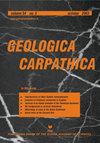New 40Ar/39Ar, fission track and sedimentological data on a middle Miocene tuff occurring in the Vienna Basin: Implications for the north-western Central Paratethys region
IF 1.5
4区 地球科学
Q4 GEOSCIENCES, MULTIDISCIPLINARY
引用次数: 21
Abstract
Abstract The Kuchyňa tuff is found on the Eastern margin of the Vienna Basin and was formed by felsic volcanism. The Ar/Ar single grain sanidine method was applied and resulted in an age of 15.23±0.04 Ma, which can be interpreted as the age of the eruption. The obtained numerical age is in accordance with the subtropical climate inferred by the presence of fossil leaves that originated in an evergreen broadleaved forest. Furthermore, the described volcanism was connected with the syn-rift stage of the back-arc Pannonian Basin system. The sedimentological data from the underlying sandy mudstones indicate alluvial environment what confirms terrestrial conditions during deposition. Moreover, the tuff deposition probably occurred shortly before the Badenian transgression of the Central Paratethys Sea.维也纳盆地中新世凝灰岩的新40Ar/39Ar、裂变轨道和沉积学数据:对中副特提斯地区西北部的启示
摘要在维也纳盆地的东部边缘发现了由长英质火山作用形成的Kuchyńa凝灰岩。采用Ar/Ar单颗粒三苯胺法测得的年龄为15.23±0.04Ma,可以解释为火山喷发的年龄。所获得的数值年龄与亚热带气候一致,亚热带气候是由常绿阔叶林中的树叶化石推断的。此外,所描述的火山活动与弧后潘诺尼盆地系统的同裂谷阶段有关。下伏砂质泥岩的沉积学数据表明,冲积环境证实了沉积期间的陆地条件。此外,凝灰岩沉积可能发生在巴登尼亚人侵入中副特提斯海之前不久。
本文章由计算机程序翻译,如有差异,请以英文原文为准。
求助全文
约1分钟内获得全文
求助全文
来源期刊

Geologica Carpathica
地学-地球科学综合
CiteScore
2.40
自引率
23.10%
发文量
26
审稿时长
>12 weeks
期刊介绍:
GEOLOGICA CARPATHICA covers a wide spectrum of geological disciplines including geodynamics, tectonics and structural geology, volcanology, stratigraphy, geochronology and isotopic geology, karstology, geochemistry, mineralogy, petrology, lithology and sedimentology, paleogeography, paleoecology, paleobiology and paleontology, paleomagnetism, magnetostratigraphy and other branches of applied geophysics, economic and environmental geology, experimental and theoretical geoscientific studies. Geologica Carpathica , with its 60 year old tradition, presents high-quality research papers devoted to all aspects not only of the Alpine-Carpathian-Balkanian geoscience but also with adjacent regions originated from the Mediterranean Tethys and its continental foreland. Geologica Carpathica is an Official Journal of the Carpathian-Balkan Geological Association.
 求助内容:
求助内容: 应助结果提醒方式:
应助结果提醒方式:


